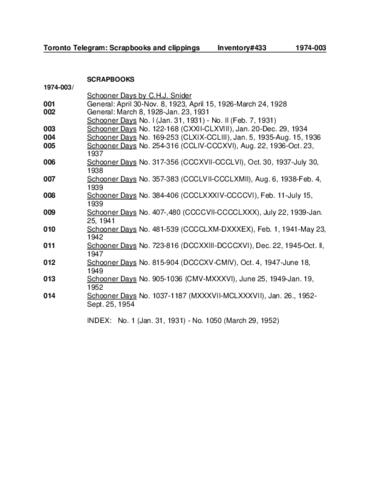Title and statement of responsibility area
Title proper
General material designation
- Textual record
Parallel title
Other title information
Title statements of responsibility
Title notes
Level of description
Reference code
Edition statement
Edition statement of responsibility
Statement of scale (cartographic)
Statement of projection (cartographic)
Statement of coordinates (cartographic)
Statement of scale (architectural)
Issuing jurisdiction and denomination (philatelic)
Dates of creation area
Date(s)
-
1876-1970 (Creation)
- Creator
- Toronto Telegram
- Place
- Toronto
Physical description area
Physical description
ca. 16 m of textual records
ca. 350 scrapbooks ; 55 x 43 cm or smaller
Title proper of publisher's series
Parallel titles of publisher's series
Other title information of publisher's series
Statement of responsibility relating to publisher's series
Numbering within publisher's series
Note on publisher's series
Archival description area
Name of creator
Administrative history
The 'Toronto telegram' (originally the 'Evening telegram,') was launched in 1876 by John Ross Robertson. The 'Tely' strongly supported the British connection in Canada, appealing to British and Imperial sentiments even after Canadian nationalism became fashionable. The newspaper was locked in a circulation war with its afternoon rival, the 'Toronto star', for much of the twentieth century. The battle involved giveaway contests, scoops, and even hiding personalities (like swimmer Marilyn Bell) from the competition to ensure exclusive stories. Following Robertson's death, the paper was continued by a trust he had established. In 1948 the newspaper was sold to George McCullagh, owner of the Toronto Globe & mail, who invited John Bassett to act as publisher. In 1952 Bassett bought the newspaper and attempted to best the Star with new features in his newspaper, the introduction of colour photography (which meant the demise of the famous 'pink' newsprint on which the "Tely" had been printed), and other modernizations (including a news office building). Falling circulation and lack of advertising led Bassett to close the newspaper in 1971.
Custodial history
Scope and content
The series consists of scrapbooks, newspaper clippings, and printed materials. The scrapbooks are of three types. The first is a collection of large scrapbooks, approximately 220 in total, that consist of copies of the 'Telegram', and its predecessor, the 'Evening Telegram'. These scrapbooks are divided into several categories of material: advertising and promotion; circulation and carriers; clubs; contests; events; daily & weekly features, such as 'Schooner Days' by C.H.J. Snider; general clippings; news features (that include articles on royal visits); outdoor activities; photo albums on personalities such as royalty and politicians; sports; theatre & opera; and feature columns and programs run by the Globe & Mail and the Toronto Star.
The second group is a collection of scrapbooks of editorials and contests of the Toronto Telegram and its rivals, the Toronto star and the Toronto Globe and Mail. The scrapbooks consist of Toronto Telegram editorials, 1962-1967; Globe and Mail editorials, 1961 1970; and Toronto Star editorials, 1940 1968. There are also indexes to Star editorials, scrapbooks concerning the Star Santa Claus Fund, 1923 1960, and the Star Fresh Air Fund.
Finally, there are two moderate sized collections of scrapbooks. The first consists of four books, covering the Toronto Transit Commission, 1950 1970. The second covers the canals of the St. Lawrence River for the period 1910 1939.
The newspaper clippings are divided into two broad areas: personalities and subjects. These consist of clippings from the 'Telegram,' arranged alphabetically by personality name, including such people as Winston Churchill, Henry Ford, Mitchell Hepburn, and Nellie McClung; and subjects ranging from abortion to medicine and from Australia to Japan. Both groups of files are complete only to the letter 'M'.
The printed material consists of accompanying material removed from the files of photoprints in the 1987-001 accession. It contains information about the subjects of the photos they were separated from and are cross referenced with those print files.
The finding aids available for this series consist of a contents list for the scrapbooks; a box list for the newspaper clippings, indicating the range of topics or names within each box; and a file list for the printed material.
Notes area
Physical condition
Immediate source of acquisition
Arrangement
Language of material
- English
Script of material
- Latin
Location of originals
Availability of other formats
Restrictions on access
Terms governing use, reproduction, and publication
Finding aids
A PDF file/item list is attached to this description.
Associated materials
Accruals
Alternative identifier(s)
Standard number
Standard number
Access points
Subject access points
Name access points
Genre access points
Control area
Status
Level of detail
Dates of creation, revision and deletion
2015-06-15 Anna St.Onge. Record created from print finding aid.
2025/06/19 J. Grant. Update to series-level description. Import of PDF finding aid.
Language of description
- English
Sources
Legacy finding aid.

